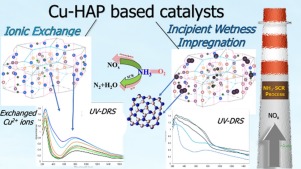Applied Catalysis A: General ( IF 4.7 ) Pub Date : 2018-06-14 , DOI: 10.1016/j.apcata.2018.06.020 M. Schiavoni , S. Campisi , P. Carniti , A. Gervasini , T. Delplanche

|
Hydroxyapatite loaded with different amounts of copper (from 2 to 11 wt.%, by using different Cu-precursors) was investigated as catalytic material for the NH3-SCR reaction. The method of copper addition affected the location and distribution of the copper phase in the hydroxyapatite samples as well as the aggregation state (isolated Cu2+ or CuxOy or CuO nano-aggregates). Ionic exchange procedure gave rise to Cu2+ stabilization in the exchange sites of HAP lattice, irrespective of the amount of Cu addition. Incipient wetness impregnation procedure provided samples with copper aggregation up to formation of CuO species at the highest Cu-loading. Sample characterization was performed by N2-adsorption/desorption, acidity measurement, EDX, TGA-DTGA, XRPD, UV–vis-DRS, and EPR to study the morphological and structural aspects of the copper phase.
Catalytic tests of NH3-SCR revealed significant differences between the samples prepared by ionic exchange and impregnation, with activity that was dependent on the copper concentration on hydroxyapatite. Presence of 6 wt.% Cu was associated to the most active catalysts, in any case. Use of Cu-chloride and Cu-nitrate as precursors of Cu-phase, with the ionic exchange procedure, gave copper-hydroxyapatite catalysts with high activity/selectivity. Use of Cu-acetate as Cu-precursor caused some modification of the hydroxyapatite surface with enrichment of carbonate groups that were detrimental for the SCR activity.
中文翻译:

着重研究铜官能化羟基磷灰石在NH 3 -SCR反应中的催化性能
研究了负载有不同量铜(通过使用不同的铜前体为2至11 wt。%)的羟基磷灰石作为NH 3 -SCR反应的催化材料。添加铜的方法影响了羟基磷灰石样品中铜相的位置和分布以及聚集状态(分离的Cu 2+或Cu x O y或CuO纳米聚集体)。离子交换过程导致HAP晶格交换位点的Cu 2+稳定化,而与添加Cu的量无关。初期湿润浸渍程序使样品具有最高的铜负载下铜聚集直至形成CuO物种。用N 2进行样品表征-吸附/解吸,酸度测量,EDX,TGA-DTGA,XRPD,UV-vis-DRS和EPR,以研究铜相的形态和结构方面。
NH 3 -SCR的催化测试表明,通过离子交换和浸渍制备的样品之间存在显着差异,其活性取决于羟基磷灰石上铜的浓度。在任何情况下,都存在6 wt。%的Cu与活性最高的催化剂有关。通过离子交换程序,使用氯化铜和硝酸铜作为Cu相的前体,得到具有高活性/选择性的铜-羟基磷灰石催化剂。乙酸铜作为铜前体的使用引起羟基磷灰石表面的一些改性,其中富含碳酸酯基团,这对SCR活性是有害的。











































 京公网安备 11010802027423号
京公网安备 11010802027423号